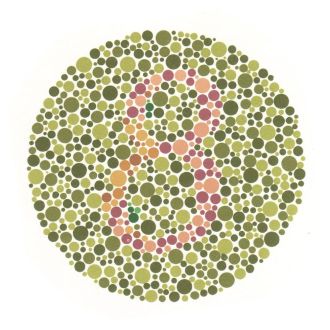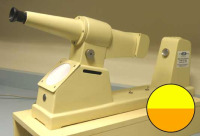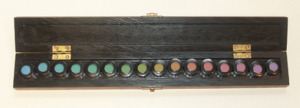“Which color is that?” is an often heard question if you are colorblind. You get used to it. You also learn how to handle it like most other difficulties which arise from your color vision deficiency.
I this article of the Color Blind Essentials series I would like to have a closer look at the every day life of a colorblind person and also at the impacts this vision handicap can have on your career choice.
Color blindness in everyday life
Most people think traffic lights are one of the biggest issue for everyone suffering from a color vision deficiency, but they are wrong. The colors for traffic lights are very well chosen and they are always arranged in a certain order. So this is not a problem at all for most colorblind people even if some states don’t allow you to get a drivers license if you are colorblind.


But there are some real handicaps for people who are suffering from some moderate to strong color vision deficiency:
- A Sunburn can’t really be seen, only if the skin is almost glowing.
- If meat is cooked can’t be told by its color.
- There is no difference between the colors for vacant (green) and occupied (red).
- Flowers and fruits can’t be that easily spotted sometimes.
- And you can’t tell if a fruit or vegetable is ripe or not yet.
- Every electrical device which uses LED lights to indicate something is a permanent source of annoyance.
- Colored maps and graphics can sometimes be very hard to decipher.
By far the most biggest issue is matching colors and specially matching clothes.
If you a have a color vision defect you can’t just choose flowers which fit together nicely, or a painting which fits with the furniture, or a carpet. You also can’t create a web site or an image with nicely matching colors. And you will never be able to easily match your shirt with your tie, your trousers with your shoes, your whole wardrobe.
In this case you need a pair of color enabled eyes which help you out. I often borrow the eyes of my wife and sometimes those of my son. They really help me a lot. ;-)
Choosing your career as a colorblind
A color vision deficiency often gets more attention when it comes to choosing a future career. Specially parents are very concerned about possible restrictions. But also young people ask themselves, if the job of their dreams will stay just a dream because of their vision handicap.
Air traffic controller
Firefighter
Police officer
Train driver
Some ranks in the armed forces
Some electrical/electronic engineers
Jobs which require good color vision can be split into two different categories. In the first of them color matching or color recognition is a main component of the job. This for example includes color quality control, art teaching, interior decorating and more.
This group of jobs is easy to decide about for colorblind people as each one knows best himself if he will perform well in such a profession or not. Most colorblind people can also accept this fact more or less easily.
The other category includes jobs which also require good color vision but only in support of the job itself. This group includes the job profiles of pilots, firefighters, police officers and more. These kind of jobs have the following facts in common:
- Bad color vision is a security problem in this job.
- Passing a color blindness test is required to qualify for the job.
- The impact of a color vision deficiency is not well described.
- There is no international standard on color vision requirements.
The points listed above unfortunately make it very complicated. Many colorblind people believe that they still could perform in such a position perfectly and that turning them down just because of their color vision deficiency is not correct. Some people even start thinking about how to cheat on such a test just to get through the exams and get the job of their dreams. But this is not the right way to go.
Here is my six steps plan towards your future career:
E
A
R
N
I
N
F
O
R
M
T
A
L
K
C
O
M
M
U
N
I
C
A
T
E
G
O
D
I
S
C
U
S
S
(1) Learn. During your time at school learn how you can handle colors. Learn about the severity of your color blindness and learn your special techniques to get around your handicap. This way you are very well prepared when it comes to choosing your future career.
(2) Inform. Get all possible information about the job of your dreams and possible handicaps for color blind people. You can get information from a prospective employer, from special authorities like the FAA for pilot candidates and of course from the internet. It’s important to check your local requirements as they can vary between different countries.
(3) Talk. Try to find some people who are working in this job and talk to them. They will know the best if there are special tasks which might be a problem and you will know from your personal experiences, if you will be able to handle and also most important if you will feel comfortable in such a position. First check your relatives, ask around in your neighborhood, maybe you will find somebody at the college and otherwise I’m sure you will be able to find somebody online who will be happy to help you out. Just check forums where those people could hang around.
(4) Communicate. Don not try to hide your color vision deficiency. Be honest and communicate it if it might be a problem. Of course you only have to do this if color vision could be a possible handicap. But it is important to inform your prospective employer what you learned about the job to be done and how you overcome those handicaps despite your imperfect color vision.
(5) Go for it. Don’t forget to take the last step. Do the required tests to learn more about your color blindness. You might pass without any problem and you might fail. You maybe also like to try different employers as there are in most jobs no national rules concerning color vision deficiency.
(6) Discuss. Did you fail the color blindness test and did they use the Ishihara plates or some similar form? Read the chapter about color blindness tests to learn about other possible tests. This should help you to start a discussion about the used test and if maybe this test was just to restrictive. There are many different tests available and sometimes it would be even much better if your prospective employer would just check possible job restrictions and if you can handle those or not.
And please don’t forget the fact, many people have some form of handicap which is a burden and sometimes becomes a big obstacle. Get used to your color blindness and try to accept that moderate to strong color blind people shouldn’t dream to work for example as a pilot or a professional firefighter. If you can’t accept this, don’t try to cheat on the tests but start a discussion about it!


We are colorblind. We can’t name colors. But we can handle most situations perfectly even if we don’t know correctly which color it really is.
In the next and last article of the Color Blind Essentials series we will learn if there are any possibilities to cure color blindness.





